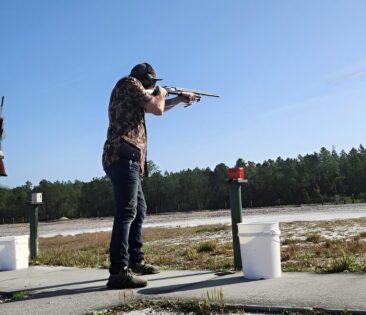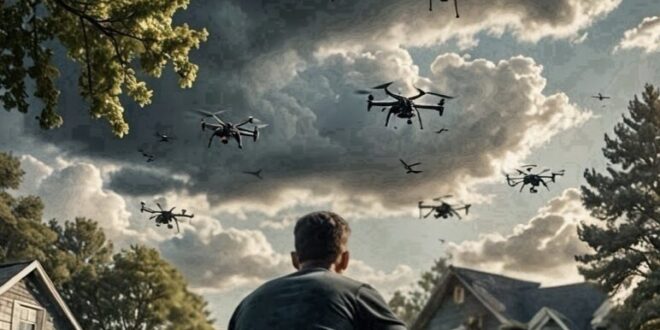by Austin Lee
Picture this: A swarm of cheap drones, hundreds strong, blotting out the Texas sun like a biblical plague of locusts. Each carries enough explosive to ruin your day, buzzing low over a sleepy border town. No radar pings, no warning; just chaos. This isn’t a Hollywood blockbuster. It’s the playbook unfolding in Ukraine, Russia, and the Middle East, and that experts fear could appear in your neighborhood. From Chinese battlefield drone tech to the New Jersey drone flap of 2024 to Mexican cartels smuggling dope across the Rio Grande, the drone threat is real, and it’s encroaching on American soil.
The Drone War Blueprint: China is Watching, Learning, and Building
Late last year, unidentified drone sightings were spotted near at least 17 U.S. military bases that are adjacent to Chinese-owned farmland. The incursions span the country, near bases in Hawaii, Utah, Florida, and elsewhere. House Foreign Affairs Committee Chairman Michael McCaul (R-Texas) has raised alarms, saying he believes some of the drones are Chinese spy craft.
“We need to identify who is behind these drones,” McCaul told reporters. “My judgment based on my experience is that those that are over our military sites are adversarial and most likely are coming from the People’s Republic of China.”
READ MORE: Amid Blood and Chaos, Foreign Powers Exploit Ukraine as a Live-Fire Test Lab
The alarm is well founded. Beijing controls 80-90% of the global commercial drone market, creating products that easily can be turned into weapons. China churns out quadcopters like the Mavic, which Ukraine transformed into grenade-toting killers. Beijing also is bolstering Russia’s drone war, supplying components for Shahed and Garpiya-3 drones, as per Ukrainian intel.

China is not the only source of potential threat. A hostile foreign actor, or some rogue outfit, could smuggle drones in shipping containers into the U.S., or 3D-print and build them stateside. With more than 1 million unregistered drones in the U.S. as of 2025, any one of them could be adapted and weaponized.
What can you expect to see and how can you respond?
Cartels Cash In: Drones on the Border
Mexican cartels are always evolving their trade tactics with the latest tech gadgets drug money can buy, and they’re flying them now to great effect. Since 2017, they’ve used drones to smuggle drugs across the U.S. border, with more than 1,000 crossings recorded by CBP in 2024 alone. Sinaloa and Jalisco New Generation cartels deploy DJI Matrice 600’s and custom quadcopters, hauling 10-20 pounds of meth, fentanyl, or coke per trip. These drones fly low, under 400 feet, dodging radar and slipping past outdated sensors. Cartels also use drones for surveillance, scouting patrol routes as much as 100 miles inland, hunting their prey or making weaponized drops.
Commercial and Hobbyist Drones
Now, add commercial delivery drones and hobbyist drones to the mix. Commercial birds, approved by the FAA for package drops, use computer vision and GPS-independent flight. Hobbyists send up drones to take pictures, or simply to play with the technology. In 2024, the FAA logged 1.4 million unregistered drones, and the skies are getting crowded.
The New Jersey drone flap, starting November 2024, saw dozens of UAVs, some bigger than hobbyist toys, buzzing reservoirs, rail stations, and even Trump’s Bedminster golf course. What were they? Commercial test flights? A defense exercise? Chinese spies? Aliens? No one knows, and that’s the problem. The lack of transparency only fuels speculation.

What happens, though, when you know you’re under attack? Patriot and THAAD systems are built for missiles, not $600 quadcopters weaving through treetops. The US Army is equipped with counter-drone microwave systems. The average citizen is not. Here’s how to fight back.
Shotguns: Your Best Counter-Drone Defense
Shotguns are the gold standard for downing drones, proven in Ukraine’s meat grinder. The AD-LER 12-gauge round, designed for the Benelli M4 Drone Guardian, packs 350 tungsten pellets (2.75mm) for a 60-meter range, shredding FPVs with 70-80% hit rates at 30-50 meters. If you can’t get AD-LER, #1 or #2 buckshot (3.8-4.3mm, 10-16 pellets) gets 60-70% hits at 20-30 meters, per Ukraine’s 93rd Kholodnyi Yar Brigade. SkyNet Mi-5 net rounds work on slow-hovering drones but are no match against fast FPVs. Stick with 3” tungsten shotshells for your best shot at taking one down.
Sporting clay shooters and hunters have a strategic advantage in this fight. Duck hunters and skeet shooters, constantly training to lead and hit 40-60 mph targets, can quickly adapt to nail 100-mph drones. Ukrainian instructors say hunters learn the fastest, intuitively tracking erratic paths. Use a 26-28-inch barrel (Benelli Supernova or Remington 870) with an improved cylinder choke for range and spread. Pair with a red dot for quick acquisition. Shorter 18-20-inch barrels (VEPR-12) suit urban fights but lose accuracy past 30 meters.
Legal Risks
Shooting drones isn’t a free-for-all. The FAA’s 2018 Reauthorization Act calls drones “aircraft,” so blasting one without cause could land you $25,000 in fines or jail time. Only feds (FAA, FBI, DHS) can legally counter drones, and only for clear threats. New Jersey bans shooting drones; Texas allows it on private land if the drone is hostile, as long as you can prove it. In that case, document the evidence with video of explosives or aggressive moves, and report to authorities fast. Know your state’s firearm laws to avoid a legal ambush.
Non-Kinetic Defenses
Defensive netting, a Ukrainian trick, stops 50% of FPVs. Lightweight nets over roads or positions snag drones or trigger payloads early. Portable net guns (MSD-5) fire five-foot meshes 30 meters, but they’re unreliable against agile FPV’s. Smoke screens (M18 grenades) or smoke machines cut FPV camera accuracy by 60-70%, though thermal-equipped drones aren’t hindered by smoke.

Acoustic sensors, like Ukraine’s Zvook, detect drones up to three miles out, boosting intercept rates to 70%. Eye and ear protection are essential, with amplified earmuff models like Walker’s Razors and other readily available devices that can pick up a drone’s buzz early, giving you an advanced incoming warning.
Fiber-optic FPV’s, tethered by 50km cables, are signal-jamming-proof and deadly. Shotguns still reign supreme for personal defense against these fiber-optic drones. Nets and smoke fail against their precision. Experimental blade-equipped quadcopters to cut fiber cables are in trials, but don’t hold your breath. Kinetic is king. Keep that shotgun close.

The author with his Mossberg 500 at the Volusia County Skeet and Trap Club
Be Your Own Defense
You don’t have to be asleep at the wheel. Grab a Mossberg 500 or Remington 870 with a 26-28-inch barrel, load AD-LER or tungsten rounds, along with some ear pro, and train at the nearest skeet range. Practice leading and shooting fast targets with the same ammunition you plan to use to take down a drone. Set up netting over key areas. Civilian-legal smoke grenades aren’t the greatest compared to what law enforcement and military have, so invest in acoustic sensors like Zvook or Stellarium SV MSD-5 for early warning.
Learn drone sounds: high-pitched whines for quadcopters, deeper hums for fixed-wings. Plenty of YouTube videos distinguish the sound differences. Push for anti-drone laws, but don’t hold your breath. An enemy swarm won’t wait for Congressional permission.
In writing this, I looked into many counter-drone systems. Some sound great but lack real results; others are too classified for us mere peasants. Grounded in hours of gritty drone footage from Ukraine, the results speak for themselves. If you’re being hunted by a drone, the best personal defense is some sporting clay practice and a 12-gauge.
Austin Lee is the proprietor of Galilhub, and is a gunsmith and a competitive shooter. He writes frequently for Soldier of Fortune.

 Soldier of Fortune Magazine The Journal of Professional Adventurers
Soldier of Fortune Magazine The Journal of Professional Adventurers






